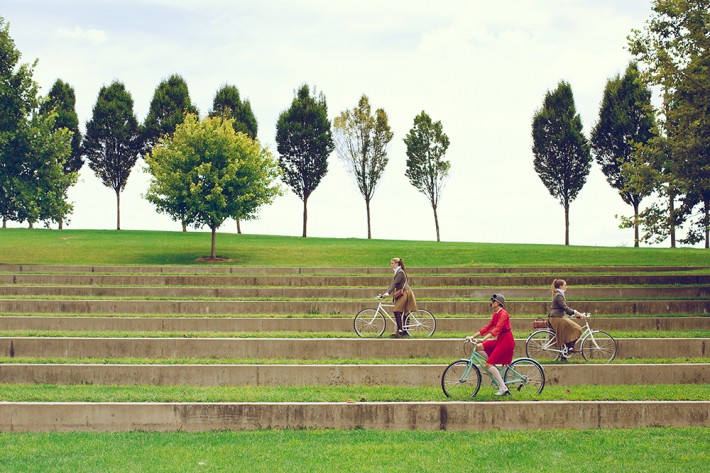Day in and day out I see images that raise the question; what is the photographer truly trying to convey in the photograph? In fashion photography, editorial story-telling is commonplace, but you must have a strong foundation for that to manifest properly in your image. Forget the lighting, focus or pose, first you need to question the frame.
In the film “The Matrix;” when Neo first realizes his power to alter the environment, the screen is washed with green lines and cryptography. Unfortunately, my transformation wasn’t altered with green lines and code, but after time and patience my eyes started to see the world in a different light. Just months into my photography career, I spent several days surveying the streets and glamorous casino halls of Las Vegas; it’s this where I found a natural ability to see symmetry and lines. After that trip, my instinct had changed and now, before snap that shutter, eye to camera, I take a long moment to scan the scene. When you look through the viewfinder and find your composition, what is your first instinct?
Lines are everything. Lines describe, define and characterize an image. Lines properly form composition and can even direct the eye. I won’t dive into the psychological jargon behind lines and I can’t tell you how you should frame this image to the next. I can only share from experience, and there is nothing more important than to sell a story in an image. Using the environment, space and subject, lines can help that hustle tremendously.
Horizontal Lines
It’s the cliché close; the helicopter soaring into the sunset or a couple holding hands walking towards “their happy future”. Just like photography, lines play a crucial role in describing the scene in cinematography. Horizontal lines give the viewer a subliminal feeling of stability or rest. That’s why so many films close peaceful with a horizon line; people walk out the theater with a sense of amity and closure. If you’re going for an ethereal or calm mood, then balance your shot and commit to more horizontal lines in the frame.

Vertical Lines
With most of my work being commercial and editorial fashion, I’ve been conditioned to shoot vertically and a lot of my images are naturally very structured. I use vertical lines to play to that statuesque structure as vertical lines give your images more power and strength. Take to heart your everyday surroundings such as tall trees, skyscrapers or pillars, vertical lines are everywhere. That being said, it’s important to keep the vertical lines parallel to the side of your frame. Get low and mind the lines, if you’re too low the vertical lines will give off a diminishing perspective and could throw off the composition.
Diagonal Lines
You may have heard of the term “dutch tilt,” a technique where the camera is titled to one side. Some signify it as a sign of an amateur, but others see it as a way to create diagonal lines, which are used to create impact and chaos. Diagonal lines are also very popular in fashion photography, as they have the ability to add a sense of movement, action or dynamic to an image. I can’t recommend using the “dutch tilt” method, but I definitely recommend using hard shadows and diagonal shapes in your composition to push a subconscious feeling of tension on your viewer.
Leading Lines
Just like some form of telepathic intellect, we as photographers and filmmakers have the power to force the viewer’s eye anywhere we want. Using a simple formula of composition and lines, we can lead the eye from one point in the photograph to another point. Be aware of staircases, railing, walls, murals and signs that could be used as a leading line. Make sure the lines point to the most important subject in the image and make sure the lines never point out of the frame.
Next time you take a step on location, stop for a moment and use your eye. View the area like a blueprint, notice the grids and lines that the location provides, this could dramatically change the way you compose your shot. It’s important to always keep the rule of thirds in mind when using lines, but rules are meant to be broken. Just remember to use those lines to find a unique composition that works for the story. Look to the edge of the viewfinder, see where the shadows fall. And, just like a bubble level, a little patience and pitch can go a long way.
If you like what you've seen here, check out more of my work on Facebook , Instagram or blog.













I love the shot with the model wearing the beanie the most because of how natural she appears in her environment. I'm not exactly sure if there's a place on this planet for the platinum blonde model though :P That must have been a wild shoot for you!
Lines are important, like a lot of other things. but i wouldn't care too much in the "strictly" research of lines, forgetting to make your subject work in the composition. In majority of pics u post, i don't think the subjects catch the attention they deserve, cause of lines...Just a consideration, don't want to critique ur work :)
Thanks for the feedback Francesco! For me it's all about the story, the subject's don't have to necessarily be the shining object in frame. :)
Also, they don't always need to be straight horizontal, vertical or diagonal lines. Curves and wavy lines can be used creatively as well.
http://www.flickr.com/photos/wupohan/3952794085/